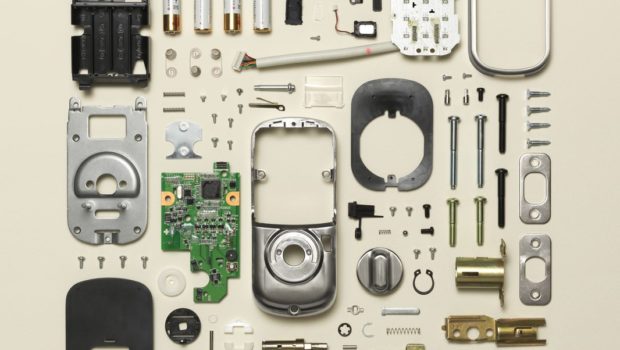Disassembly of a smart lock.
DISASSEMBLY REPORT
- MODEL: Yale Assure Lock SL Connected by August
- PRODUCED: Shanghai, china
- NUMBER OF PARTS: 115
- TIME TO DISASSEMBLE: 1 hour, 12 minutes
Has any renter in history ever heeded the “Do not duplicate” dictum on the face of an apartment key? What if you get locked out? Better make a copy for your neighbor. Plus a set for when you go running. And then your sister comes to stay for two weeks, so she needs one too. On it goes. And then one goes missing. Mechanical keys have been with us for a long, long time—at least since the Romans, and probably longer—and their biggest weakness has always been that they are objects, which can be broken, copied, lost, and found. Now comes the smart lock and a new conception of keys: that they should be more like user profiles on a computer. Are you allowed to come into my home at any time of day? Okay, then here’s this key. The teenager’s key stops working after curfew. Deliveryman? Here’s a key you can use exactly once. It’s a great system. The only thing wrong with it is the name. The guts of the lock are basically the same. They should have called them smart keys.
INSTALLING THE LOCK
You install a smart lock in pretty much the same way you would a traditional lock. The latch mechanism (13), which includes the bolt (11), installs in the door along the long horizontal axis. The strike plate (9) gets affixed to the doorjamb so it aligns with the bolt. The exterior escutcheon (2)—which is where the keyhole would be, but here is only a screen (4)—mounts to the latch assembly on the outside of the door. On the inside—the secure side—you screw the mounting plate (5) in place, then attach the interior escutcheon, which features a thumb turn (10) for operating the lock from the inside. The interior escutcheon is also where you install the batteries, which feels like a weird thing to have to do for a door lock, and a network module (1), which allows the lock to talk to other smart systems, like Amazon Key for deliveries, or August Connect, which lets you control the lock from anywhere with Wi-Fi. Which feels even weirder.
USING THE "KEYS"
Once the lock is installed, you program in a master code using the keypad (3). That’s like the administrator password. It’s required to register new people with new PIN codes. Once it’s set, you can create codes for anyone who might need to get in (including you). When you come home from work, you tap the screen; the keys light up, you punch in your code. It’s validated by the microprocessor (6), and the door unlocks. (Note: A mechanical key isn’t only a security device—it’s also a tool for transmitting force from your muscles to the bolt. Absent the key, the smart lock uses a motor [12] to actuate the bolt.)
So what can go wrong? If the batteries die—they last for about a year, and the lock warns you when they get low, so they shouldn’t—you can give the lock temporary power by holding a nine-volt battery against two terminals (8) below the screen. If at that point your PIN doesn’t work, someone may have activated privacy mode, using the privacy mode button (7). In that mode, PIN codes don’t work. You might use it at night, when you don’t want to get Kramered by the neighbor you gave a code to because at reasonable hours you’re buds. If the lock isn’t in privacy mode, and your PIN still doesn’t work, you’ve either forgotten it—the new way to lose your keys—or, well, someone decided you’re just not welcome anymore.
This content is created and maintained by a third party, and imported onto this page to help users provide their email addresses. You may be able to find more information about this and similar content at piano.io
This commenting section is created and maintained by a third party, and imported onto this page. You may be able to find more information on their web site.









Gloss